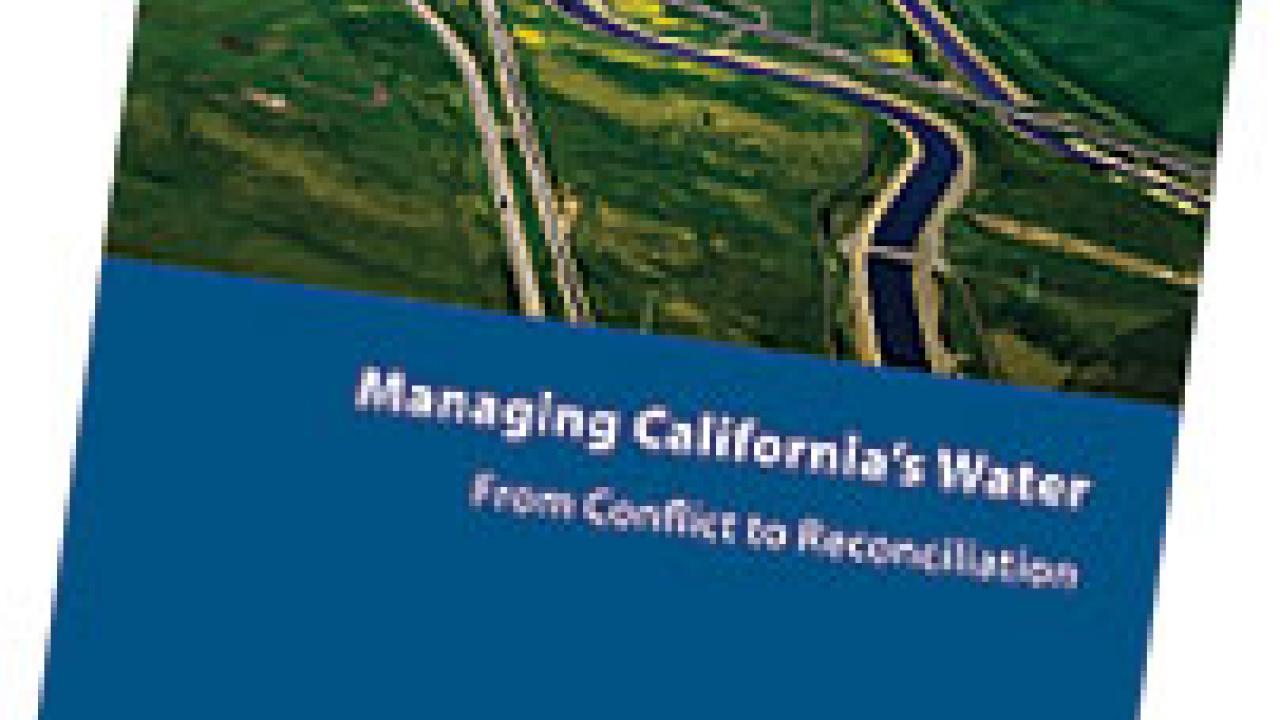California’s water management system is deteriorating — on both economic and environmental fronts. Only a broad, integrative approach will reverse the decline, according to a new book released today by experts from UC Davis, the Public Policy Institute of California, UC Riverside, UC Hastings College of the Law and Stanford University.
It is the first time in 40 years, the authors say, that independent experts have come together to offer a long-term view of the water challenges throughout California. In “Managing California’s Water: From Conflict to Reconciliation,” experts in geology, fish ecology, engineering, economy and law urge a more comprehensive approach to meeting the growing demand for reliable water supply, healthy ecosystems and flood protection.
“California must take bold steps to make water management more effective environmentally and economically,” says co-author Jay Lund, a UC Davis professor of environmental engineering, director of the watershed sciences center and an adjunct fellow at the policy institute.
“Our water policies were made for historical problems and have not kept up with changes in our society and economy, or tremendous declines in native fish species. We continue to fall behind.”
Almost 80 percent of the state’s 129 native fish species are extinct or imperiled. Efforts to stop the declines now threaten water-supply reliability and flood management. As nonnative species continue to invade, water diversions increase and cold-water habitat becomes scarce, the outlook for native species worsens.
Rather than focus on one species at a time, the book’s authors suggest several strategies to improve whole ecosystems, including: removing or pushing back levees to promote seasonal flooding, reducing contaminants, limiting introduction of invasive species, improving environmental performance of some dams and removing others altogether.
Another key recommendation is to incorporate a wider range of tools to manage water supply, quality and flooding, beyond the current system of levees, dams, conveyance facilities and treatment plants. Additional tools include:
• Urban conservation — Californians use much more water than economically advanced countries with similar climates, such as Australia, Israel and Spain. Reducing water use to about 155 gallons per person a day — 30 percent below 2000 levels — would significantly reduce urban demand for exports from the Sacramento-San Joaquin Delta.
• Groundwater banking — Expanding underground storage can be much more cost-effective than building new surface storage. Groundwater banking can stretch available water supplies and replace storage lost due to a shrinking Sierra Nevada snowpack.
• Water transfers — Buying and selling water is an equitable way to accommodate changing demands and compensate water-rights holders, the authors argue. For instance, water marketing has considerable potential in agricultural regions where farmland is planted in low-value crops, but steps are needed to reduce current legal and institutional barriers.
• Pollution management — Progress has been made in cleaning up wastewater and industrial discharges. But runoff from farms, construction sites and urban streets and gardens is not well managed. Cap-and-trade programs could lower the costs of implementing standards for pollutant discharges.
• Flood management — Flood risks are high and growing, and investment has been inadequate to maintain flood-protection infrastructure. Land-use planning should focus on limiting new development in flood-prone areas, improving building codes and expanding flood insurance requirements. Higher fees for properties benefiting from flood protection would bolster the state’s woefully underfunded system.
A major weakness of California’s water system is fragmentation — hundreds of local and regional agencies separately manage supply, quality, floods and habitat, according to the report. To avoid confusion and missed opportunities, the authors propose creating regional stewardship authorities — on the scale of watersheds — to coordinate functions.
In addition to Lund, the co-authors are Ellen Hanak, PPIC; Richard Howitt, Jeffrey Mount and Peter Moyle, UC Davis; Ariel Dinar, UC Riverside; Brian Gray, UC Hastings College of the Law; and Barton "Buzz” Thompson, Stanford University Law School.
This book continues earlier UC Davis and PPIC collaborations that explored proposed solutions to the Delta's problems, such as “Comparing Futures for the Sacramento–San Joaquin Delta” in 2008.
“Managing California’s Water: From Conflict to Reconciliation” is published by the PPIC and supported with funding from the S.D. Bechtel Jr. Foundation, David and Lucile Packard Foundation, Pisces Foundation, Resources Legacy Fund, and Santa Ana Watershed Project Authority.
On Wednesday, March 2, the book will be the subject of a Washington, D.C., seminar that can be viewed online. Lund, Hanak and others will discuss new approaches to balancing economic and environmental goals for water management. The webcast begins at 9:45 a.m. Pacific time. Information: http://www.rff.org/Events/Pages/Water-Conflicts-and-Resolution-Economy-vs-Environment.aspx.
About the UC Davis Center for Watershed Sciences
The Center for Watershed Sciences, a unit of the John Muir Institute of the Environment, is dedicated to the interdisciplinary study of critical issues in watershed science and policy. http://watershed.ucdavis.edu.
Media Resources
Jay Lund, UC Davis Center for Watershed Sciences, 530-752-5671, jrlund@ucdavis.edu
